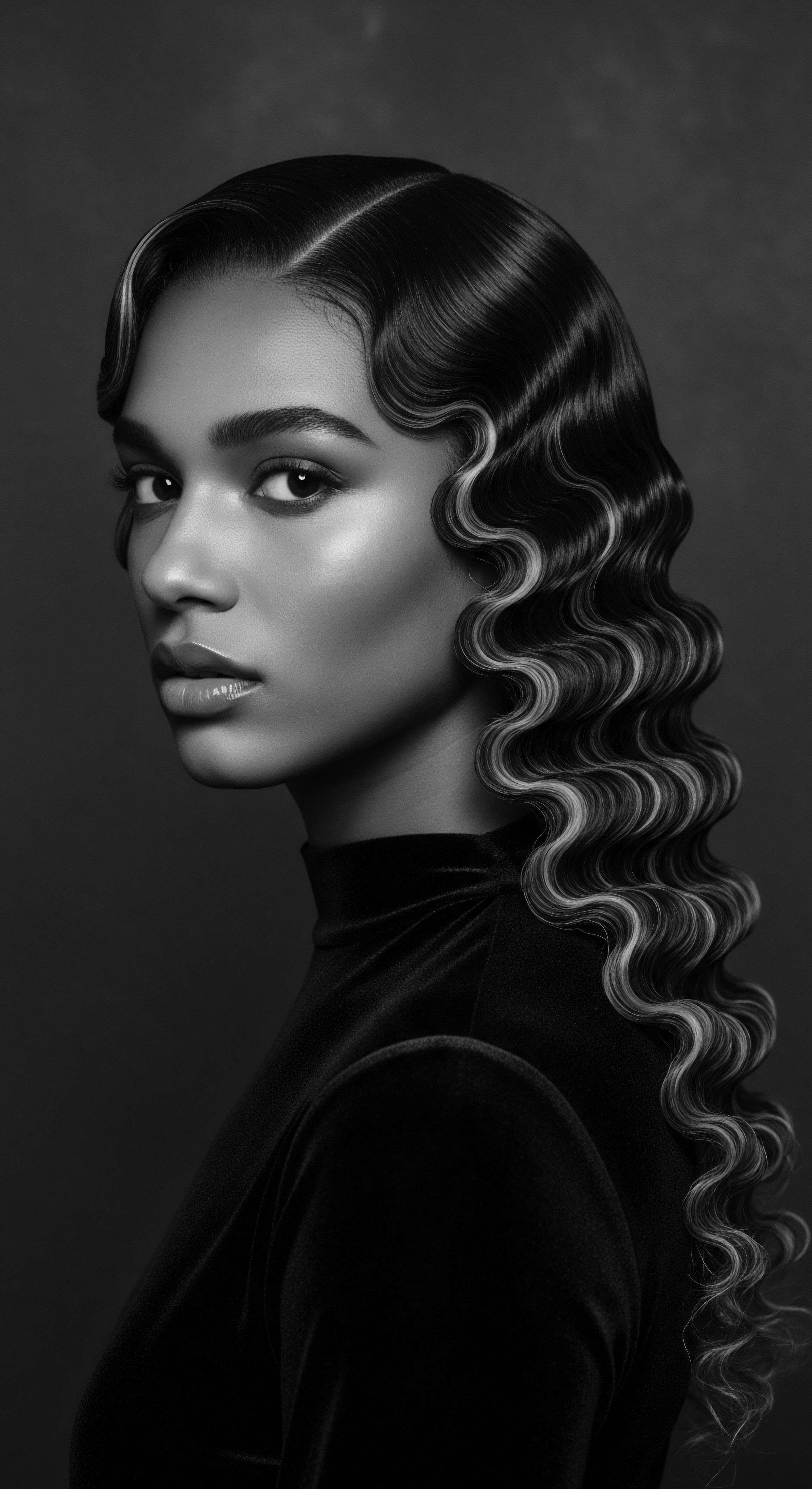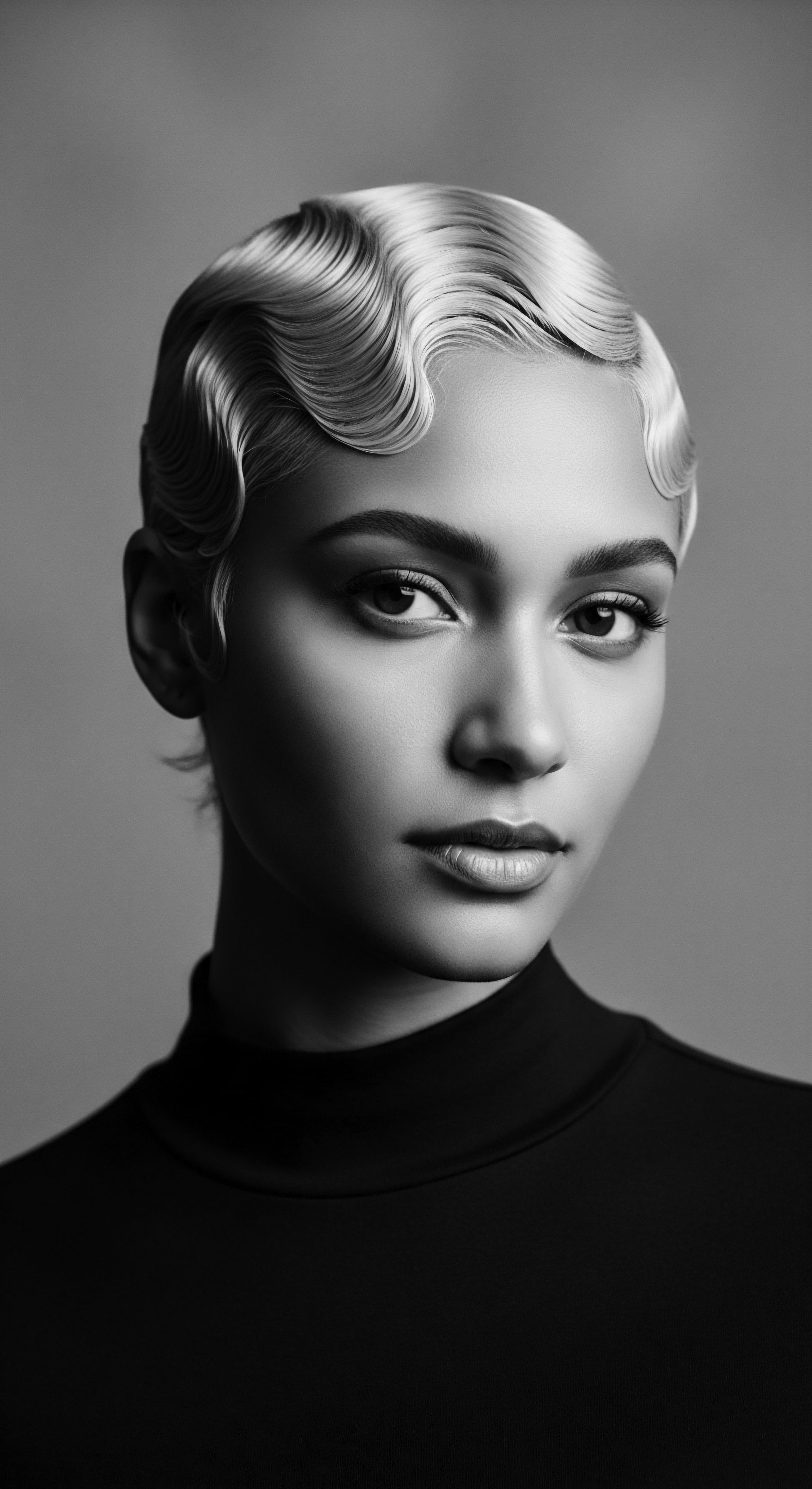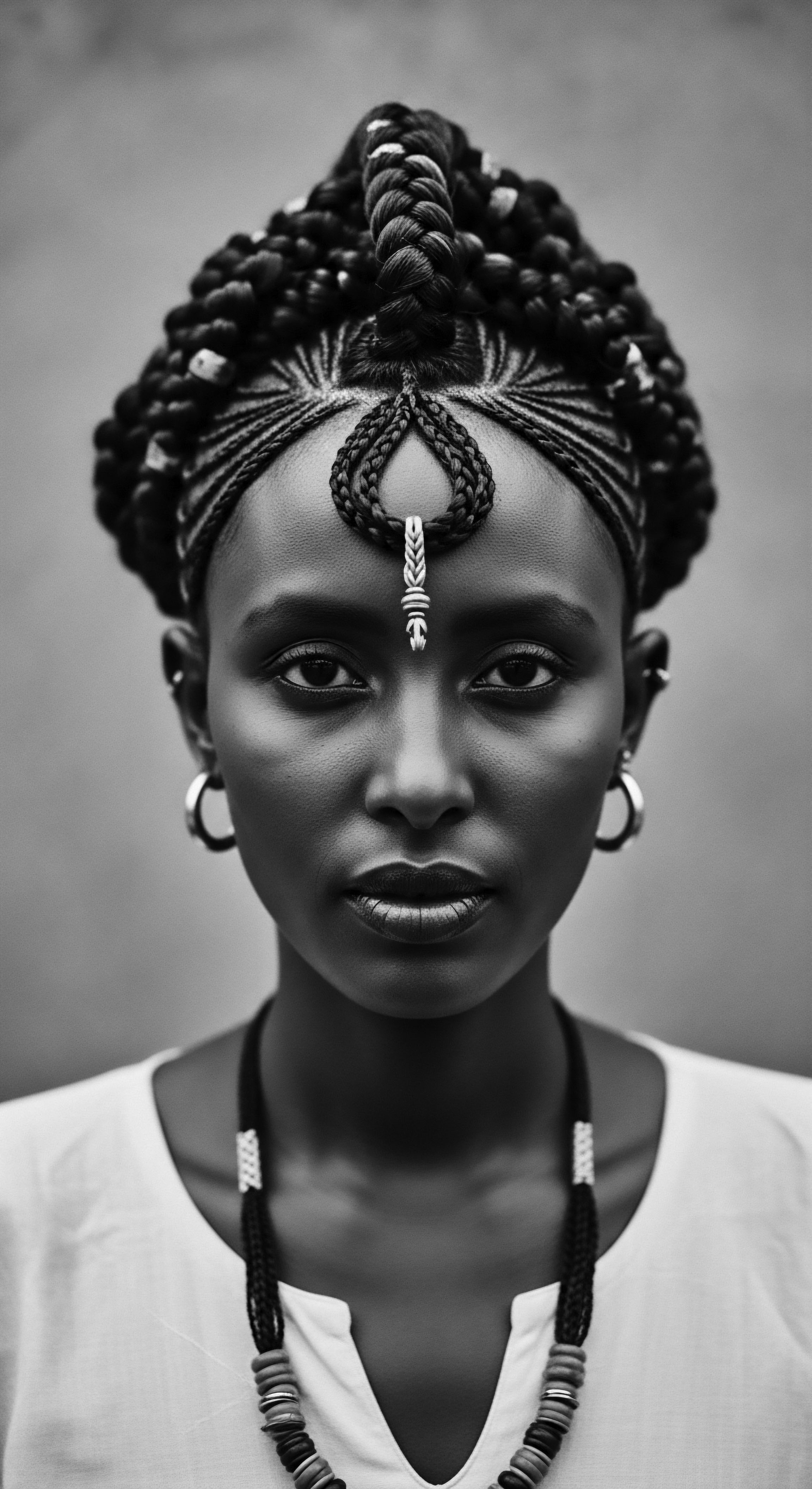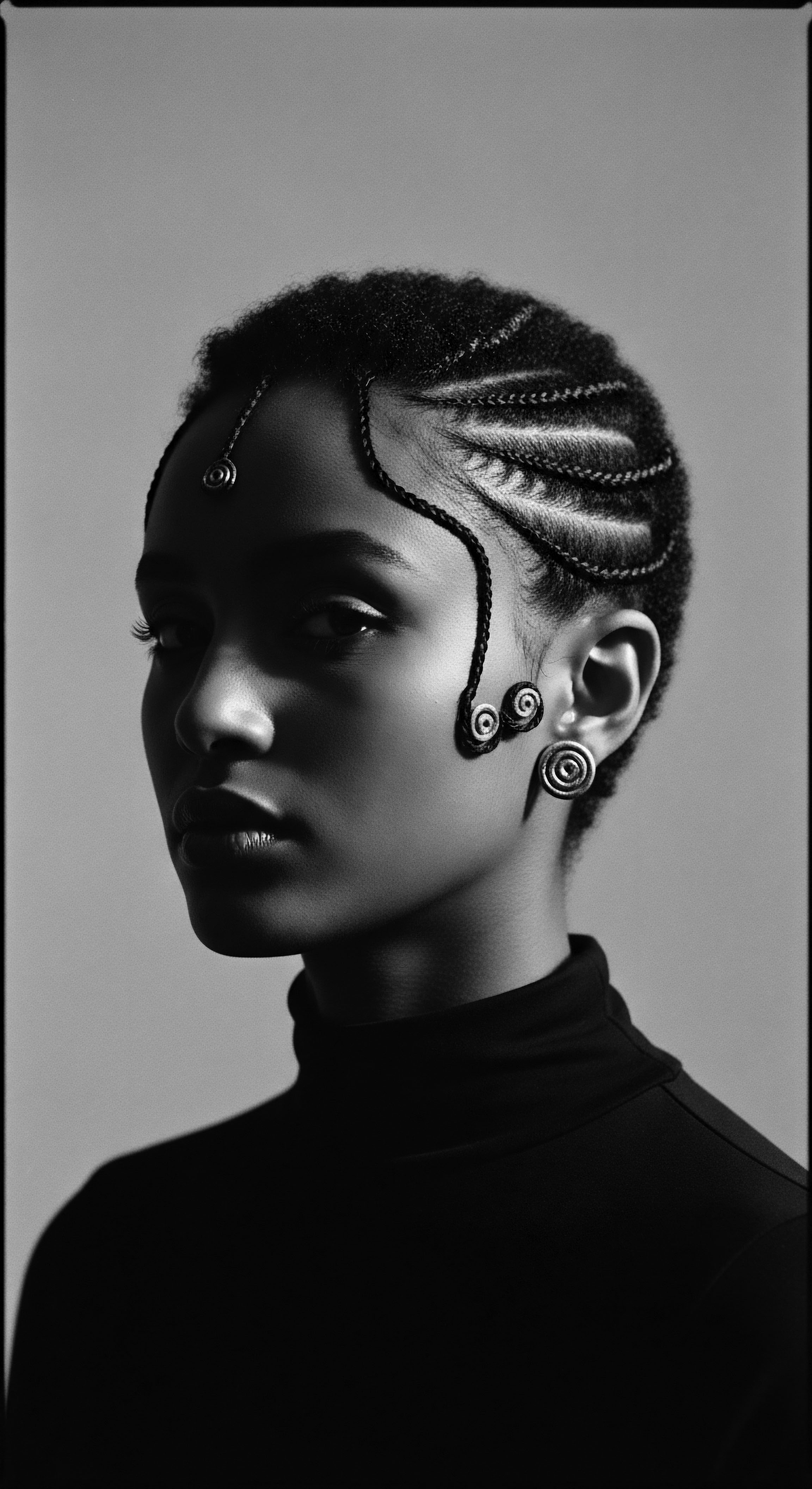
Roots
The story of a textured strand begins not with a product, nor even a philosophy, but with the very earth that birthed it. It is a chronicle held in the curl, a legacy spiraling from the scalp, carrying the wisdom of countless sunrises and generations. For those whose crowns wear the artistry of coils and kinks, the journey of hair care is never simply a routine; it is a remembrance.
It is a quiet dialogue with the past, a recognition that the needs of our hair are as deeply etched as our ancestral lines. Why, then, does the very mention of shea butter seem to whisper a profound truth to textured hair, as if its very being holds the ancient answer?

The Ancestral Understanding of the Strand’s Form
The unique architecture of textured hair, with its inherent turns and twists, creates a surface different from straighter forms. Where a straight strand might allow natural scalp oils to glide effortlessly down its length, a coiled or kinky strand presents a delightful, yet challenging, terrain. Each turn marks a potential point of lift for the outer layer, the cuticle, the protective scales of the hair.
This natural lift means a more open surface, inviting moisture in, certainly, but also permitting its escape with a greater ease. This anatomical reality—a biological predisposition towards dryness—was not a deficiency in ancestral eyes, but simply a condition of being, something understood and addressed through practices honed over millennia.
In communities across West Africa, where the shea tree, Vitellaria paradoxa, stands as a benevolent elder, this profound relationship between hair and environment has shaped a sophisticated understanding of care. The women who tended their families’ hair, often beneath the shade of these very trees, perceived the hair’s tendency to thirst, its desire for substantive nourishment. Their hands, guided by inherited wisdom, sought out natural substances that could meet this need. The knowledge was passed down through observation, through touch, through the tangible results of their remedies.
The deep, coiled structure of textured hair inherently presents more surface area for moisture to depart, a reality long addressed by ancestral practices centered on substantive, natural emollients.

What Intrinsic Qualities Does Shea Butter Offer Our Heritage Strands?
Shea butter emerges from the nuts of the karité tree, a substance not merely used, but revered. Often termed “Women’s Gold” in West Africa, it represents a pillar of economic self-reliance and a fountain of communal well-being. But beyond its societal value, its molecular structure speaks a language that textured hair comprehends intimately. This butter holds a rich concentration of fatty acids—oleic, stearic, linoleic, and palmitic acids among them—that mirror the natural lipid content of our skin and hair.
This kinship with the hair’s own protective elements means shea butter does not simply sit on the surface; it offers a gentle, substantial presence. It helps to form a subtle, yet effective, barrier against the harsh elements, reducing the rapid evaporation of water from the hair shaft.
Consider too, the unsaponifiable components within raw shea butter—a fraction of the butter that does not convert into soap when combined with lye. These unsaponifiables, which can account for up to 11% of the butter, are rich in beneficial compounds, including vitamins A and E, and cinnamic acid esters. These are not just scientific terms; they represent the plant’s inherent capacity to soothe, to protect, and to fortify.
Vitamin A aids in cell reproduction, supporting a healthy scalp environment for hair to flourish, while Vitamin E provides a measure of defense against environmental challenges. For hair that often experiences environmental exposure, particularly in tropical climates, these qualities are not supplemental; they are foundational.

Traditional Practices Affirming Shea’s Place
Across the “Shea Belt” of West Africa, which spans over 20 countries, the application of shea butter to hair has been a consistent practice for centuries. It was applied to keep hair moisturized, to aid in complex braiding styles, and to protect against sun, wind, and dust. The wisdom of these traditions, passed from mother to daughter, recognized the butter’s ability to imbue hair with pliability and a subtle lustre.
A study conducted in Northern Ghana found that Shea Butter was the most commonly utilized plant by women for skin smoothening and hair enhancement, a direct affirmation of its deep-seated role in traditional cosmetic practices. This is not a modern discovery; it is a validation of ancestral insight. The women of the Himba tribe in Southwestern Namibia, for instance, have traditionally used mixtures containing butterfat and ochre to dreadlock their hair, a practice demonstrating a historical understanding of butter’s efficacy in shaping and preserving textured strands. This continuity of practice across diverse communities, from the ancient Egyptians who reputedly valued shea oil to contemporary Ghanaian women, speaks to an enduring, intrinsic benefit that transcends time and evolving beauty landscapes.
| Traditional Observation Hair feels softer and more manageable. |
| Scientific Explanation of Benefit Emollient fatty acids coat the hair shaft, smoothing cuticles and reducing friction. |
| Traditional Observation Hair retains moisture longer in dry climates. |
| Scientific Explanation of Benefit Forms a protective lipid barrier, limiting transepidermal water loss from the strand. |
| Traditional Observation Scalp feels soothed and less irritated. |
| Scientific Explanation of Benefit Anti-inflammatory compounds like cinnamic acid calm scalp irritation. |
| Traditional Observation Hair appears stronger with regular use. |
| Scientific Explanation of Benefit Vitamins A and E offer antioxidant protection, supporting the hair shaft's integrity. |
| Traditional Observation The enduring legacy of shea butter in hair care highlights a profound resonance between inherited cultural practices and contemporary scientific validation. |

Ritual
The act of caring for textured hair is often more than a chore; it is a ritual, a sacred pause in the day that connects us to a lineage of hands that have nurtured similar crowns. Within this deeply personal and communal practice, shea butter has occupied a central space, not merely as an ingredient, but as an active participant in the ceremonies of transformation and preservation. This engagement with shea butter goes beyond its elemental biology; it steps into the realm of lived tradition, where its properties are woven into the very fabric of styling, protection, and self-expression.

Ancestral Roots of Protective Styling
Protective styles—braids, twists, cornrows, and their countless variations—are not modern inventions; they are a direct inheritance from diverse African cultures, practices honed for centuries to safeguard hair from environmental rigors and to convey social narratives. From the intricate patterns that once signaled status, age, or marital standing in 15th-century West Africa, to the covert messages sometimes woven into cornrows during eras of immense struggle, these styles speak volumes without uttering a word. Shea butter, often handmade by women through labor-intensive traditional methods, served as an indispensable partner in these styling endeavors.
The application of shea butter before, during, or after braiding was not arbitrary. Its lubricating quality, owing to its rich fatty acid profile, allowed for smoother sectioning and easier manipulation of strands. For coils that naturally resist linear alignment, the butter provided the necessary slip, reducing breakage during the creation of these lasting styles.
After the style was complete, shea butter would then seal in moisture, providing a protective sheath against the elements, helping to maintain the integrity of the style itself and the health of the hair within it. This practice ensured that the intricate work endured, allowing the wearer to move through their days with both beauty and comfort.

How Did Shea Butter Shape Styling Techniques Historically?
The very composition of shea butter—solid at room temperature, yet melting readily with body heat—made it an ideal medium for traditional hair dressings. Its creamy consistency, a world away from thin oils, provided a substantive hold and definition without the need for synthetic additives. This made it particularly suited for the distinct needs of highly textured hair.
Consider, for a moment, the practice of hair threading, native to the Yoruba people of Southwestern Nigeria, dating back to the 15th century. This technique, which involves wrapping strands of hair tightly with thread, relies on careful manipulation and the ability to elongate the hair without heat. While not explicitly mentioned in every historical account as partnered with shea butter, the need for a pliable, conditioned strand to endure such manipulation is apparent. A thick, conditioning butter, applied to moisturized hair, would have provided the elasticity and smoothness needed to allow these intricate, length-retaining styles to be created with minimal strain.
The practice of mixing substances like Chébé Powder with moisturizing butters, followed by braiding to lock in hydration by Chadian women, further exemplifies the historical understanding of such emollients as foundational to preserving hair integrity within protective styles. This demonstrates a timeless understanding of the substance’s capacity to assist styling, keeping the crown supple and strong.
Shea butter’s unique texture and emollient properties have, for centuries, rendered it an invaluable partner in the creation and maintenance of protective styles across African cultures.
- Lubrication ❉ Its smooth texture allowed for cleaner partings and reduced friction during braiding or twisting.
- Moisture Sealant ❉ A protective barrier was formed, locking in water and vital nutrients, preserving hydration within the hair shaft.
- Enhanced Pliability ❉ It softened the hair, making it more flexible and less prone to snapping during manipulation into intricate styles.
- Natural Definition ❉ Its substantive quality helped to sculpt and hold the natural curl pattern within styles, providing lasting shape.

Shea Butter’s Role in Natural Styling and Definition
Beyond long-term protective styles, shea butter has been a trusted ally in defining the inherent beauty of textured hair in its natural state. The desire to enhance the natural curl, coil, or kink pattern is not a recent phenomenon. For centuries, individuals have sought ways to showcase the organic artistry of their hair.
Shea butter, with its ability to coat the hair without weighing it down excessively, allows individual strands to clump and form defined patterns. This process, known today as curl grouping or definition, was intuitively understood and practiced long before scientific terms emerged.
The butter’s consistent use as a hair dressing, especially for thick, curly, or kinky hair, speaks to its efficacy in providing definition and reducing frizz, a common concern for hair that tends to expand in search of moisture. The way ancestral hands worked the butter through the hair—often gently rubbing it to melt and distribute—was a precise art, one that harnessed the butter’s properties to create a cohesive, lustrous crown. It was a practice not rooted in cosmetic vanity, but in the desire for health, order, and a dignified presentation of self within the community. The act of applying it became a moment of grounding, a connection to the material world and to the wisdom embodied in its natural abundance.
| Traditional Hair Practice Braiding & Twisting |
| Benefit for Textured Hair Through Shea Butter Reduces breakage during manipulation, smooths strands, provides hold. |
| Traditional Hair Practice Scalp Massage |
| Benefit for Textured Hair Through Shea Butter Soothes scalp, helps distribute natural oils, may promote a healthy environment for growth. |
| Traditional Hair Practice Hair Dressings/Pomades |
| Benefit for Textured Hair Through Shea Butter Adds shine, definition, and a protective layer against environmental exposure. |
| Traditional Hair Practice Chebe Powder Mixtures |
| Benefit for Textured Hair Through Shea Butter Provides a moisturizing base that helps lock in hydration when applied before braiding. |
| Traditional Hair Practice From ceremonial adornment to daily protection, shea butter has served as a foundational element in textured hair styling practices, ensuring both beauty and resilience. |

Relay
The journey of textured hair care, from ancient practices to contemporary understandings, forms a continuous relay, a passing of knowledge and reverence across generations. In this ongoing narrative, shea butter remains a consistent, compelling voice, bridging the ancestral and the scientific, offering its enduring properties as a cornerstone of holistic care and problem-solving. Its benefits extend beyond mere aesthetics, reaching into the realm of wellness, identity, and the quiet strength of inherited wisdom.

How Does Shea Butter’s Chemistry Support Textured Hair Health?
To comprehend shea butter’s profound benefit, we must delve beyond its textural appeal into its molecular architecture. The butter is a complex matrix of triglycerides, primarily composed of stearic acid and oleic acid, along with a notable unsaponifiable fraction. This unsaponifiable matter, a significant distinction from many other plant oils, houses bioactive compounds that contribute to shea butter’s unique efficacy.
Oleic Acid, a monounsaturated fatty acid, helps shea butter penetrate the hair shaft, delivering its conditioning benefits deeply. This is particularly advantageous for textured hair, which often struggles with retaining internal moisture due to its coiled structure and potentially lifted cuticles. Stearic Acid, a saturated fatty acid, contributes to the butter’s solid consistency at room temperature and its ability to form a protective film on the hair’s surface once applied. This film acts as a shield against environmental aggressors and, more importantly, a seal against moisture loss, a perpetual challenge for many textured hair types.
Furthermore, the presence of vitamins A and E within shea butter provides vital antioxidant properties. These vitamins help protect hair from oxidative stress caused by sunlight and environmental pollutants, factors that can degrade hair proteins and weaken strands. Cinnamic acid esters, another component of the unsaponifiable fraction, possess anti-inflammatory qualities, offering soothing relief to the scalp. A healthy, calm scalp environment is foundational for optimal hair growth and overall strand vitality, a truth understood intuitively by ancestral practitioners who used shea for scalp massage and healing.

Ancestral Wisdom Informing Modern Regimens
The concept of a “regimen of radiance” for textured hair, with its emphasis on consistent care, deep conditioning, and nighttime protection, finds deep resonance in ancestral practices. Long before commercial products codified multi-step routines, African communities practiced meticulous hair care, often integrated into daily life. The use of shea butter was not a singular application but part of a continuous cycle of care.
For instance, the tradition of nighttime hair covering, with silk or satin materials, is directly linked to preserving moisture and preventing breakage against rough sleep surfaces. This practice, now widely advocated for textured hair, likely evolved from an innate understanding of how to safeguard intricate styles and delicate strands through the hours of rest. While not exclusively about shea butter, the butter’s role in daily moisture application would have necessitated such protective measures to prolong its benefits.
This holistic approach extends to ingredient selection. While modern science can isolate and analyze compounds, ancestral wisdom relied on centuries of empirical observation. The consistent re-emergence of shea butter in hair care throughout history underscores its proven efficacy. This is not about one-time fixes, but about sustained, mindful engagement with what the earth offers to support the inherent strength of textured hair.
The chemical composition of shea butter directly addresses the intrinsic needs of textured hair, forming a protective barrier while delivering vital nutrients and soothing the scalp.

Addressing Hair Challenges with Ancient Solutions
Textured hair, by its very structure, can be more prone to dryness and breakage, leading to common concerns such as frizz, tangling, and a perceived lack of growth. Shea butter, with its historical application across diverse challenges, offers time-tested solutions that modern science continues to affirm.
For dryness, the butter acts as a powerful humectant, drawing moisture from the air and locking it into the hair shaft, a critical function for coils that tend to lose water rapidly. Its emollient properties also work to smooth the hair’s cuticle, reducing the friction that often leads to tangles and knots. When the cuticle is smooth, strands glide past one another with greater ease, preserving length and reducing the likelihood of mechanical damage.
The concern over hair growth, often a misinterpretation of length retention, also finds an ally in shea butter. While shea butter itself may not directly stimulate follicular growth, its ability to reduce breakage and create an optimal scalp environment certainly supports the appearance of healthier, longer hair over time. When hair is less prone to breaking, it retains its length, appearing to “grow” more effectively. This was likely the observed effect in traditional practices that noted its benefit for “hair growth”.
- Dryness ❉ Shea butter provides a rich, lasting moisture seal, diminishing the perpetual thirst of textured strands.
- Breakage ❉ Its emollient qualities increase hair elasticity, reducing fragility and friction points.
- Scalp Discomfort ❉ Anti-inflammatory properties soothe irritation, supporting a balanced scalp ecosystem.
- Styling Aid ❉ Offers a natural hold and definition, supporting intricate cultural styles and enhancing natural patterns.

Shea Butter as a Holistic Influence on Hair Health
The ancestral wisdom surrounding shea butter extends beyond its immediate physical effects; it encompasses a holistic view of well-being where the health of the body, spirit, and community are intertwined. The very act of preparing shea butter, traditionally a communal endeavor of women, fostered bonds and shared knowledge. This communal aspect imbues the ingredient with a cultural weight that transcends its chemical composition.
In this context, using shea butter for hair care is a participation in a living legacy. It is a mindful choice that honours the resourcefulness of those who came before, connecting individual well-being to a broader cultural narrative. It is a quiet act of defiance against narratives that once sought to diminish or erase the intrinsic beauty of textured hair and the practices that sustained it. The journey of shea butter, from the sacred tree of the savannah to the palms of our hands, carries with it the enduring spirit of resilience, tradition, and profound care.

Reflection
To truly grasp the intrinsic benefit of shea butter for textured hair, one must step beyond a simple catalog of its properties and enter the vibrant, living archive of heritage. It is a story not simply told, but lived, embodied in every coil, every twist, every kinky turn. The ‘Soul of a Strand’ ethos acknowledges that textured hair is more than keratin and bonds; it is a profound connection to ancestry, to resistance, and to a beauty that has always known its worth. Shea butter, in its quiet power, stands as a testament to this enduring lineage.
From the very soil of West Africa, where the karité tree has sustained communities for millennia, to the contemporary routines practiced globally, shea butter has been a constant. Its fatty acids and protective vitamins speak directly to the unique needs of hair that thrives on deep moisture and a gentle hand. This is not a fleeting trend, but a validation of inherited wisdom, a tangible link to the practices of grandmothers and great-grandmothers who intuitively understood what their strands required. Their hands, working the rich butter, were not merely conditioning hair; they were preserving a cultural continuity, a self-knowledge that refused to be fragmented.
As we continue to explore and celebrate the magnificent diversity of textured hair, shea butter remains a beacon. It is a reminder that the most potent solutions often lie in the elemental gifts of the earth, in the traditions passed down with reverence, and in the deep understanding of our own unique biological and cultural inheritances. It allows us to carry forward a legacy of care, not as a burden, but as a luminous thread connecting us to all who have walked before, honoring the enduring spirit of every textured crown.

References
- Abbiw, D. (1990). Useful Plants of Ghana ❉ West African Uses of Wild and Cultivated Plants. Intermediate Technology Publications.
- Hemsley, J. H. (1968). Vitellaria paradoxa C. F. Gaertn. (Sapotaceae). Flora of Tropical East Africa.
- Kazeem, M. I. Ogungbe, S. M. Saibu, G. M. & Aboyade, O. M. (2014). In Vitro study on the hypoglycemic potential of Nicotiana tabacum leaf extracts. Bangladesh Journal of Pharmacology, 9(3), 140-145.
- Lamien, N. et al. (1996). Ethnobotanical Survey of Shea (Vitellaria Paradoxa Gaertn.) in Burkina Faso. Paper presented at the International Symposium on Sustainable Development of the Shea Tree.
- Maranz, S. & Wiesman, Z. (2003). Influence of environmental conditions on the content of tocopherols in shea butter. Journal of Agricultural and Food Chemistry, 51(20), 5727-5730.
- Neuwinger, H. D. (1994). African Ethnobotany ❉ Poisons and Drugs ❉ Chemistry, Pharmacology, Toxicology. Chapman & Hall.
- Rajbonshi, P. (2021). Shea Butter ❉ A Comprehensive Review on Its Cultivation, Processing, and Potential Applications. International Journal of Agriculture and Food Science Technology.
- Sarmadi, B. & Aminuddin, M. (2015). Fatty acid composition of shea butter (Vitellaria paradoxa) from different regions of West Africa. Journal of Oleo Science, 64(4), 433-439.
- Vuzi, P. (2011). Folk Classification of Shea Butter Tree (Vitellaria paradoxa subsp. nilotica) Ethno-varieties in Uganda. Ethnobotany Research and Applications, 9, 243-256.
